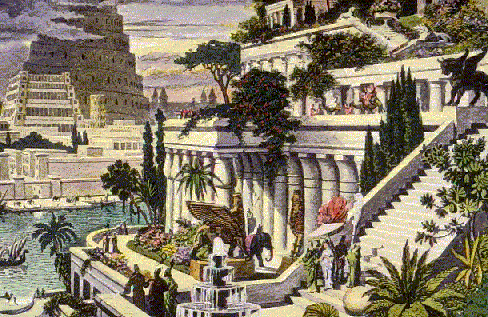





The Hanging Gardens of Babylon (also known as the Hanging Gardens of Semiramis) and the walls of Babylon (present-day Iraq) were considered one of the Seven Wonders of the World. They were both supposedly built by Nebuchadnezzar II around 600 BC .
The Hanging Gardens are extensively documented by Greek historians such as Strabo and Diodorus Siculus, but otherwise there is little evidence for their existence. In fact, there are no Babylonian records of any such gardens having existed. Some (circumstantial) evidence gathered at the excavation of the palace at Babylon has accrued, but does not completely substantiate what look like fanciful descriptions.
Some schools of thought think that through the ages the location may have been confused with gardens that existed at Nineveh as tablets from there clearly showing gardens have been found. Writings on these tablets describe the possible use of something similar to an Archimedes' screw as a process of raising the water to the required height.
According to accounts, the gardens were built to cheer up Nebuchadnezzar's homesick wife, Amyitis. Amyitis, daughter of the king of the Medes, was married to Nebuchadnezzar to create an alliance between the nations. The land she came from, though, was green, rugged and mountainous, and she found the flat, sun-baked terrain of the Mesopotamia (a region of southwest Asia) depressing. The king decided to recreate her homeland by building an artificial mountain with rooftop gardens.
The Hanging Gardens probably did not really "hang" in the sense of being suspended from cables or ropes. The name comes from an inexact translation of the Greek word kremastos or the Latin word pensilis, which means not just "hanging" but "overhanging," as in the case of a terrace or balcony.
The Greek geographer Strabo, who described the gardens in the first century BC, wrote, "It consists of vaulted terraces raised one above another, and resting upon cube-shaped pillars. These are hollow and filled with earth to allow trees of the largest size to be planted. The pillars, vaults, and terraces are constructed of baked brick and asphalt."
More recent archaeological excavations at the ancient city of Babylon in Iraq uncovered the foundation of the palace. Other findings include the Vaulted Building with thick walls and an irrigation well near the southern palace. A group of archaeologists surveyed the area of the southern palace and reconstructed the Vaulted Building as the Hanging Gardens.
However, the Greek historian Strabo had stated that the gardens were situated by the River Euphrates. So others argue that the site is too far from the Euphrates to support the theory since the Vaulted Building is several hundreds of meters away.
They reconstructed the site of the palace and located the Gardens in the area stretching from the River to the Palace. On the river banks, recently discovered massive walls 25 m thick may have been stepped to form terraces... the ones described in Greek references.
SACRED PLACES AND TEACHINGS INDEX